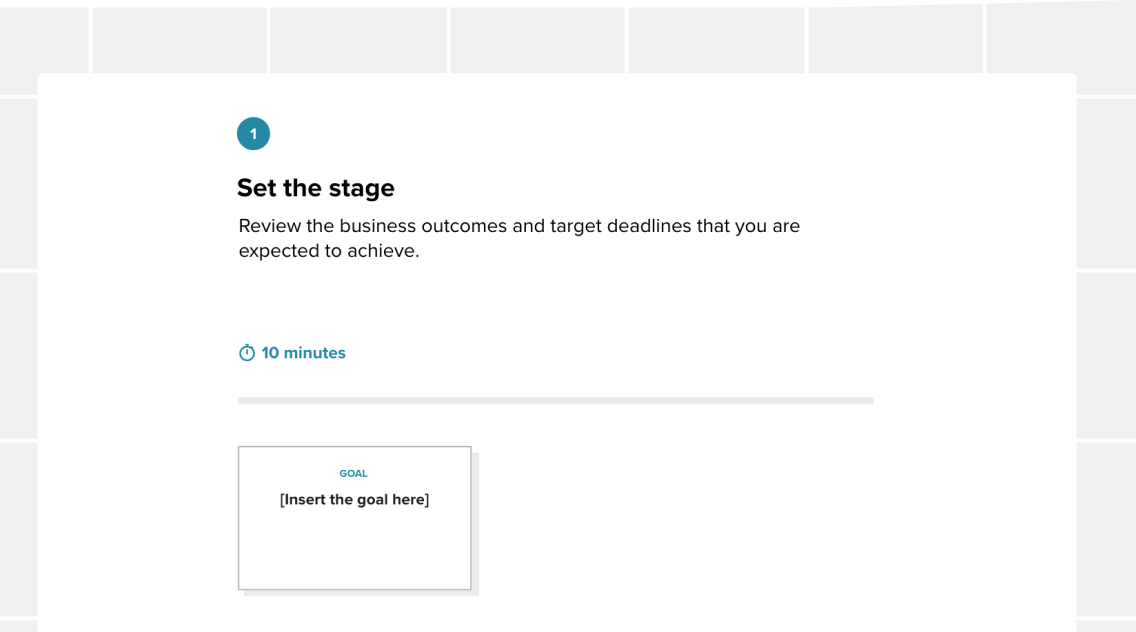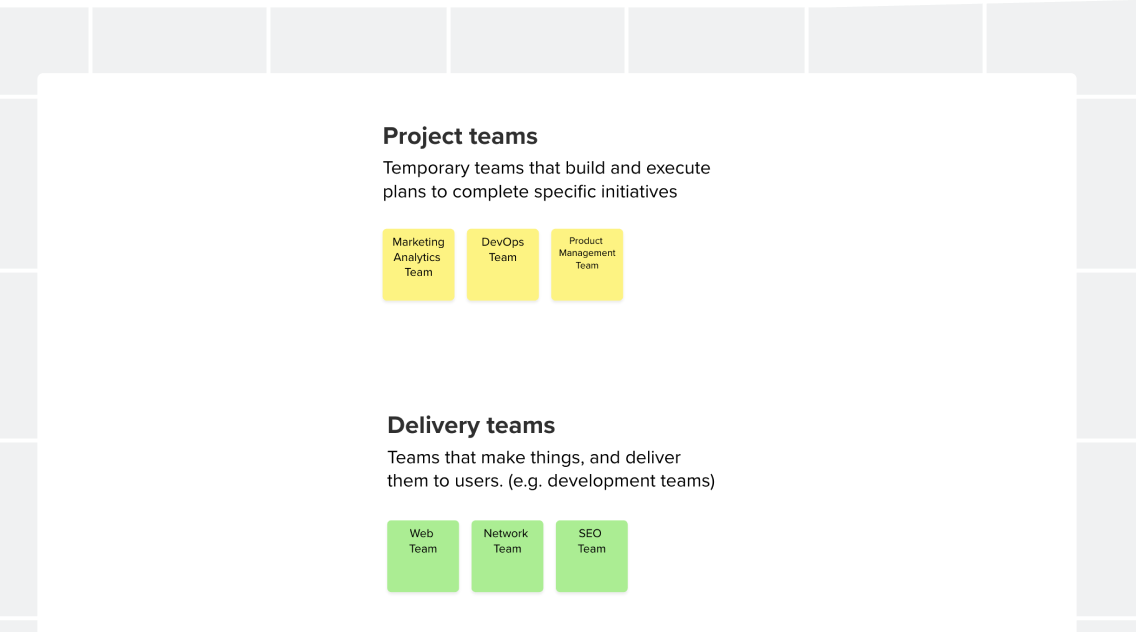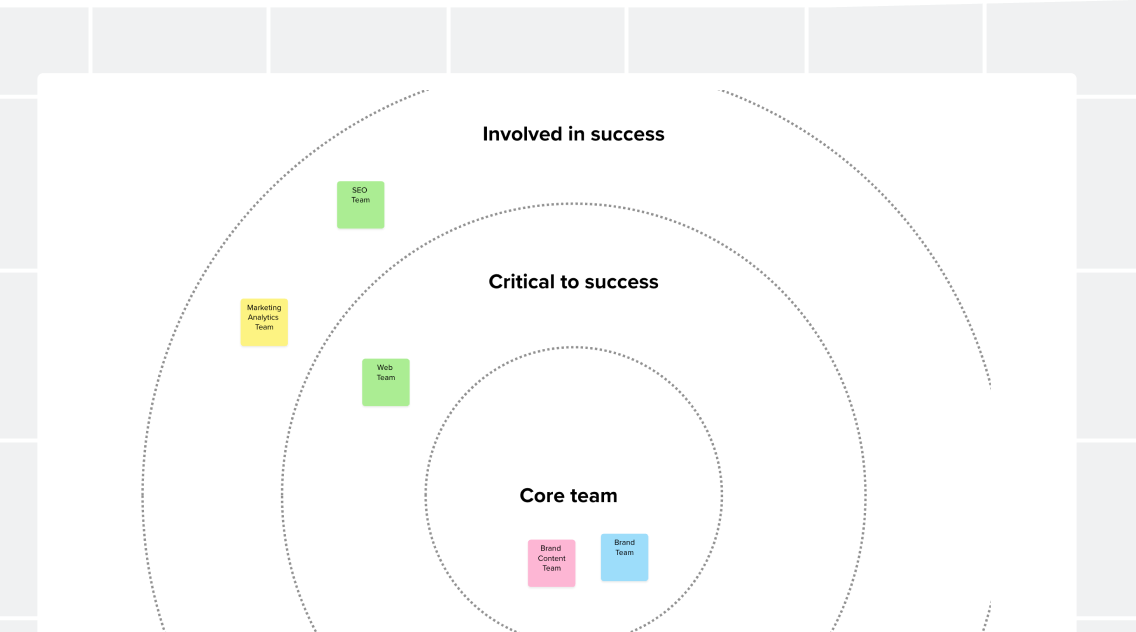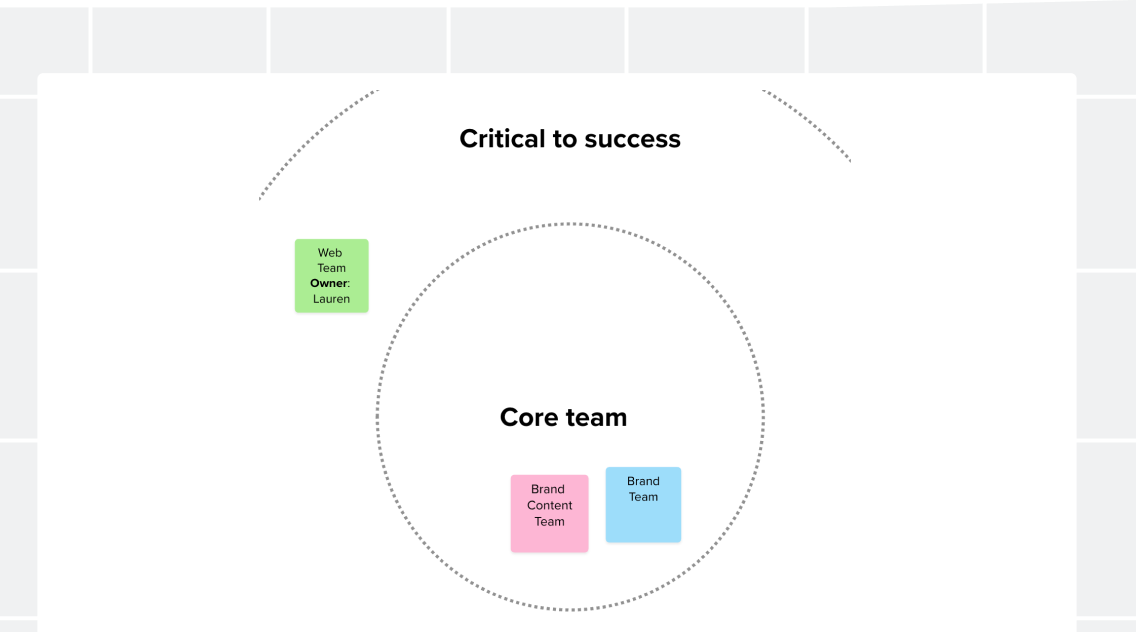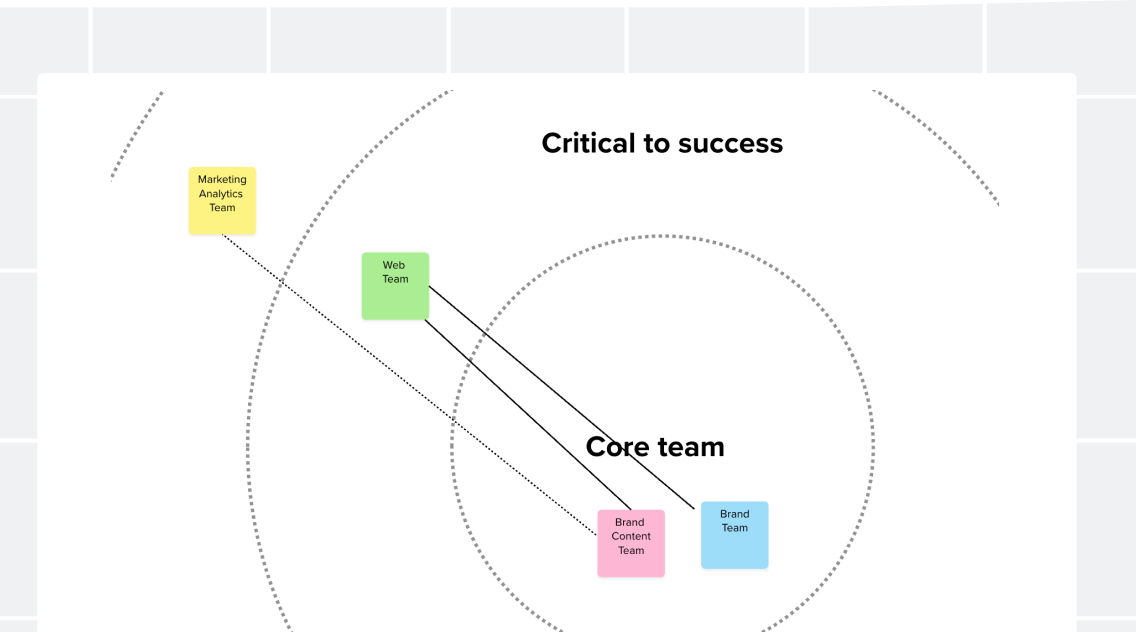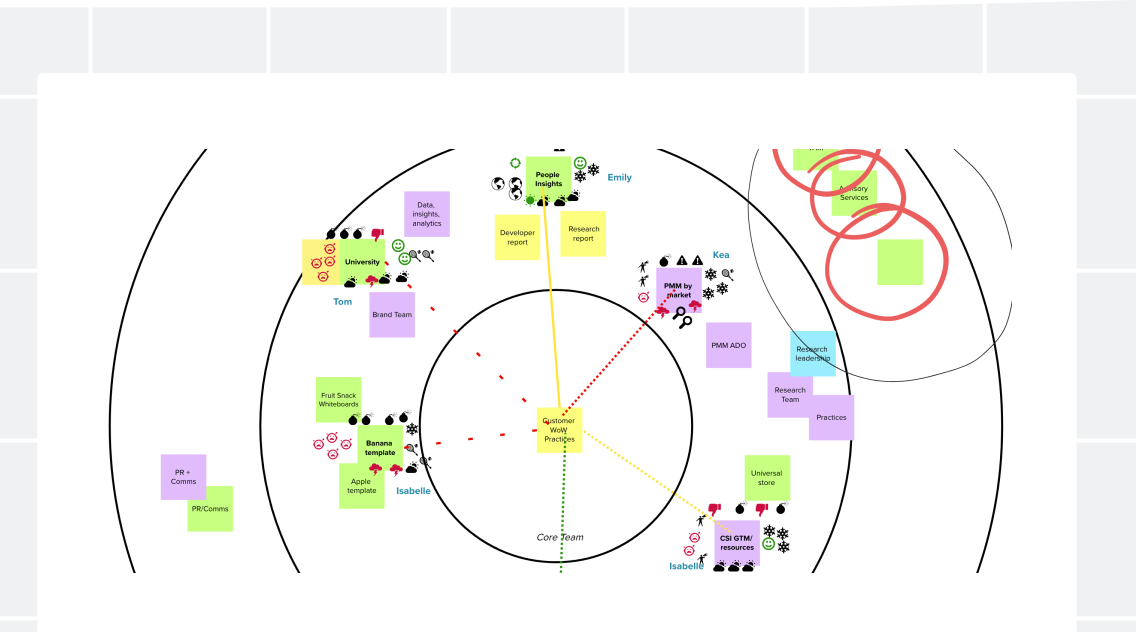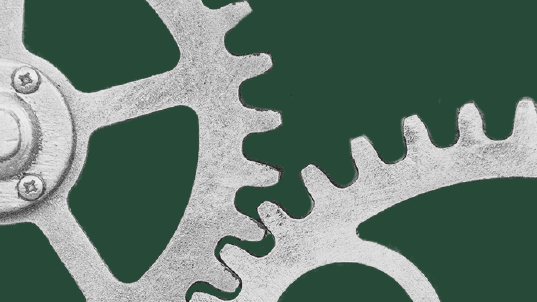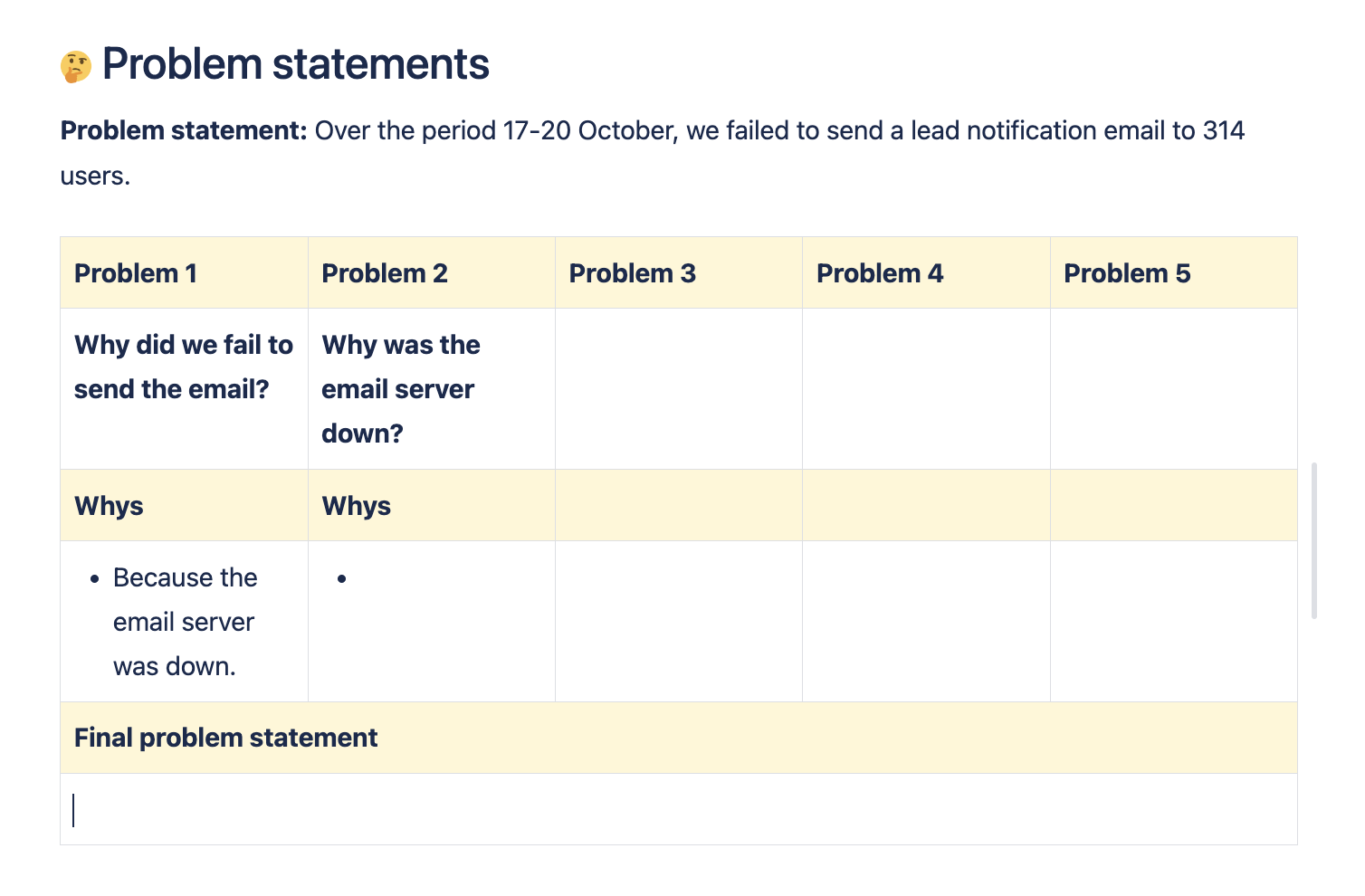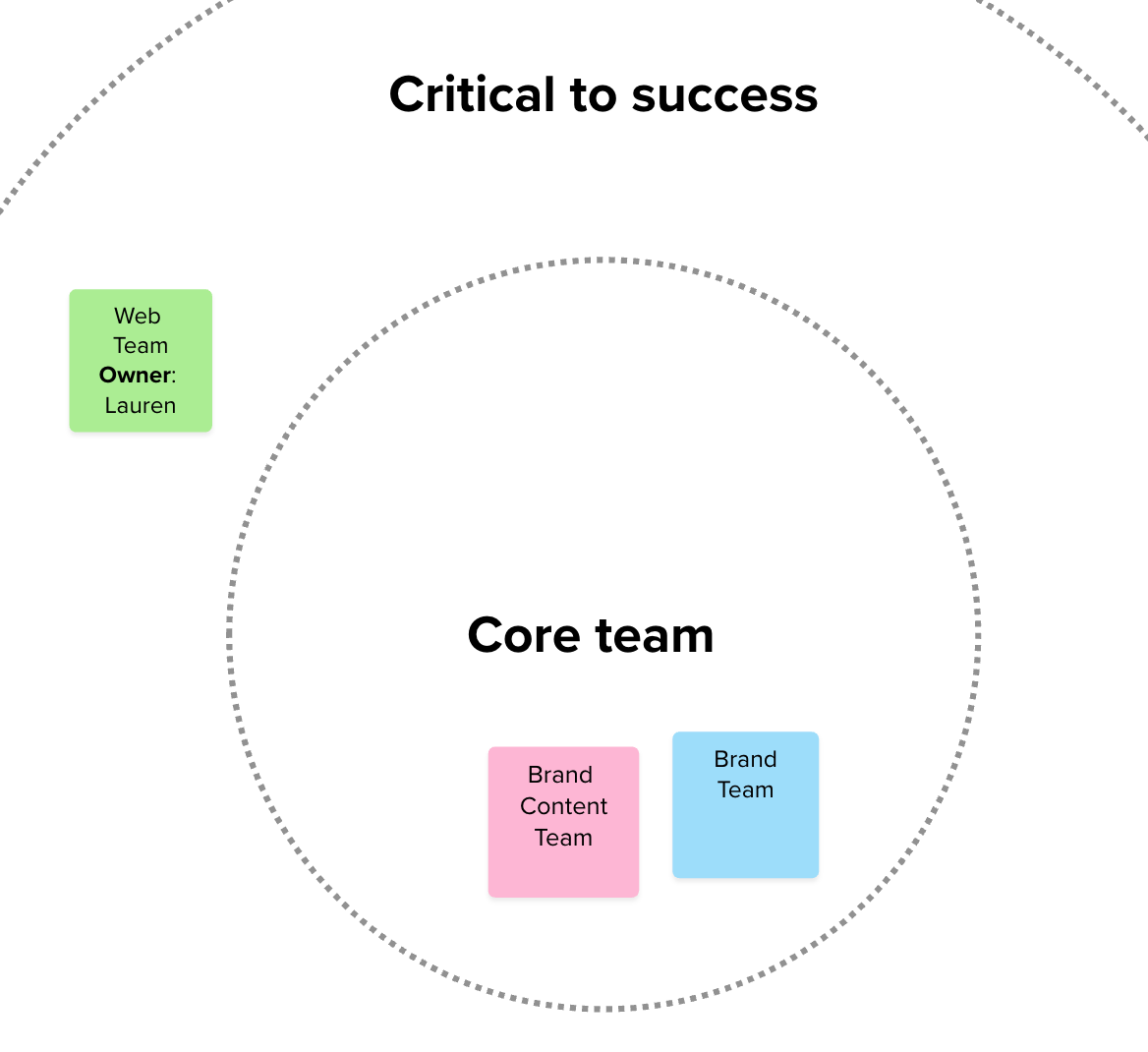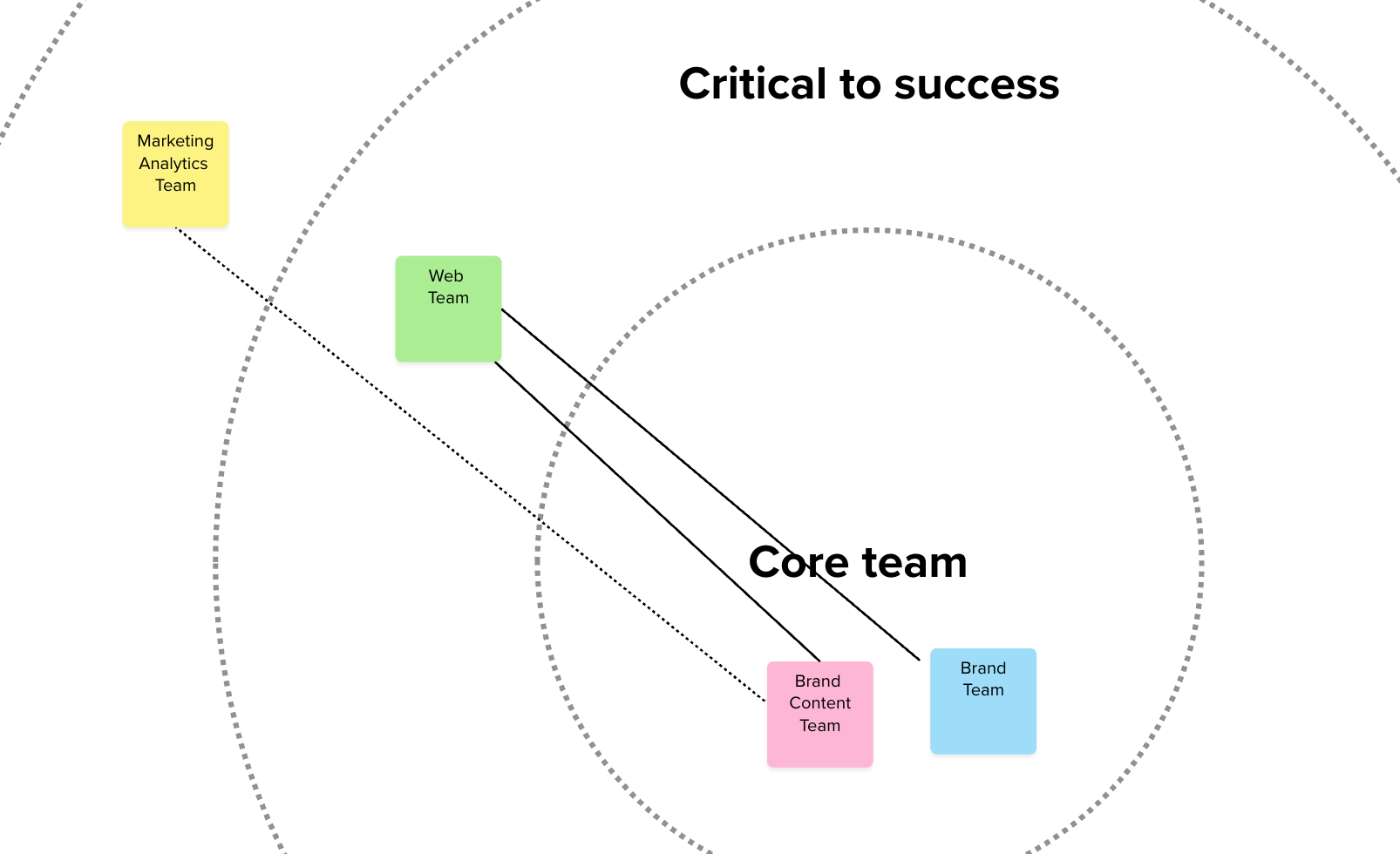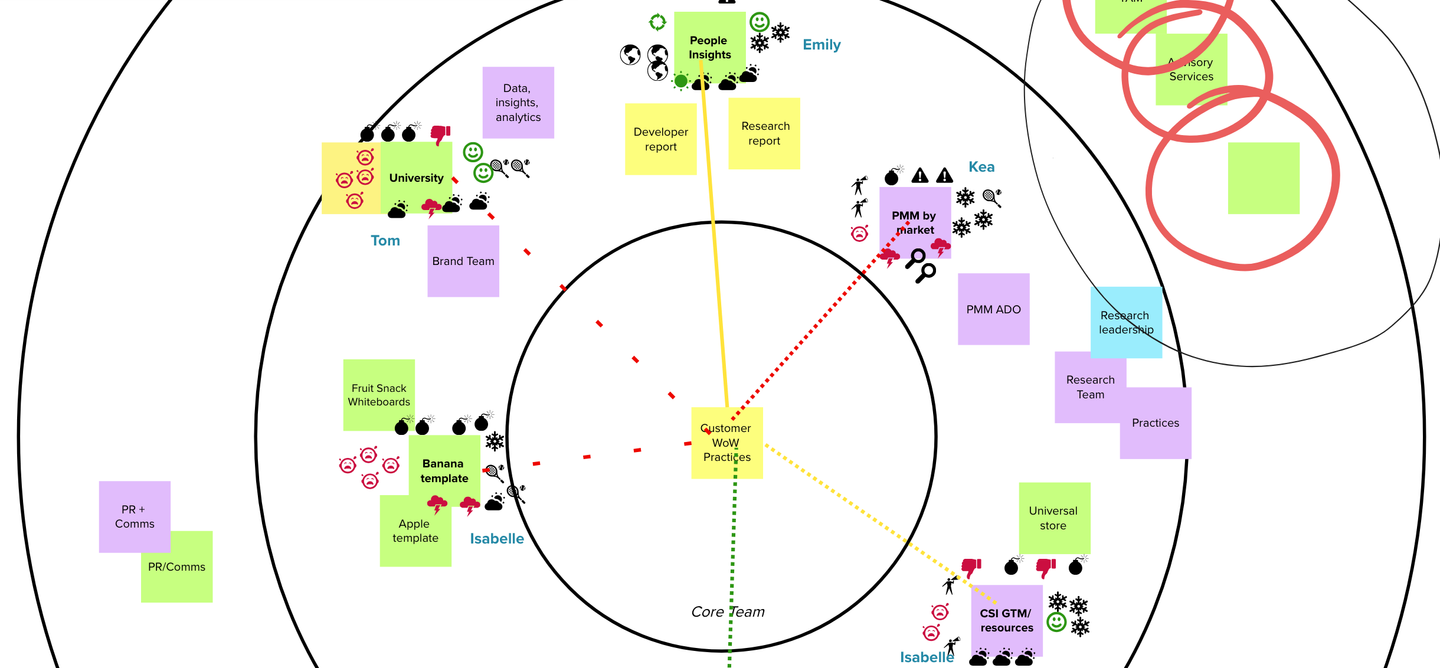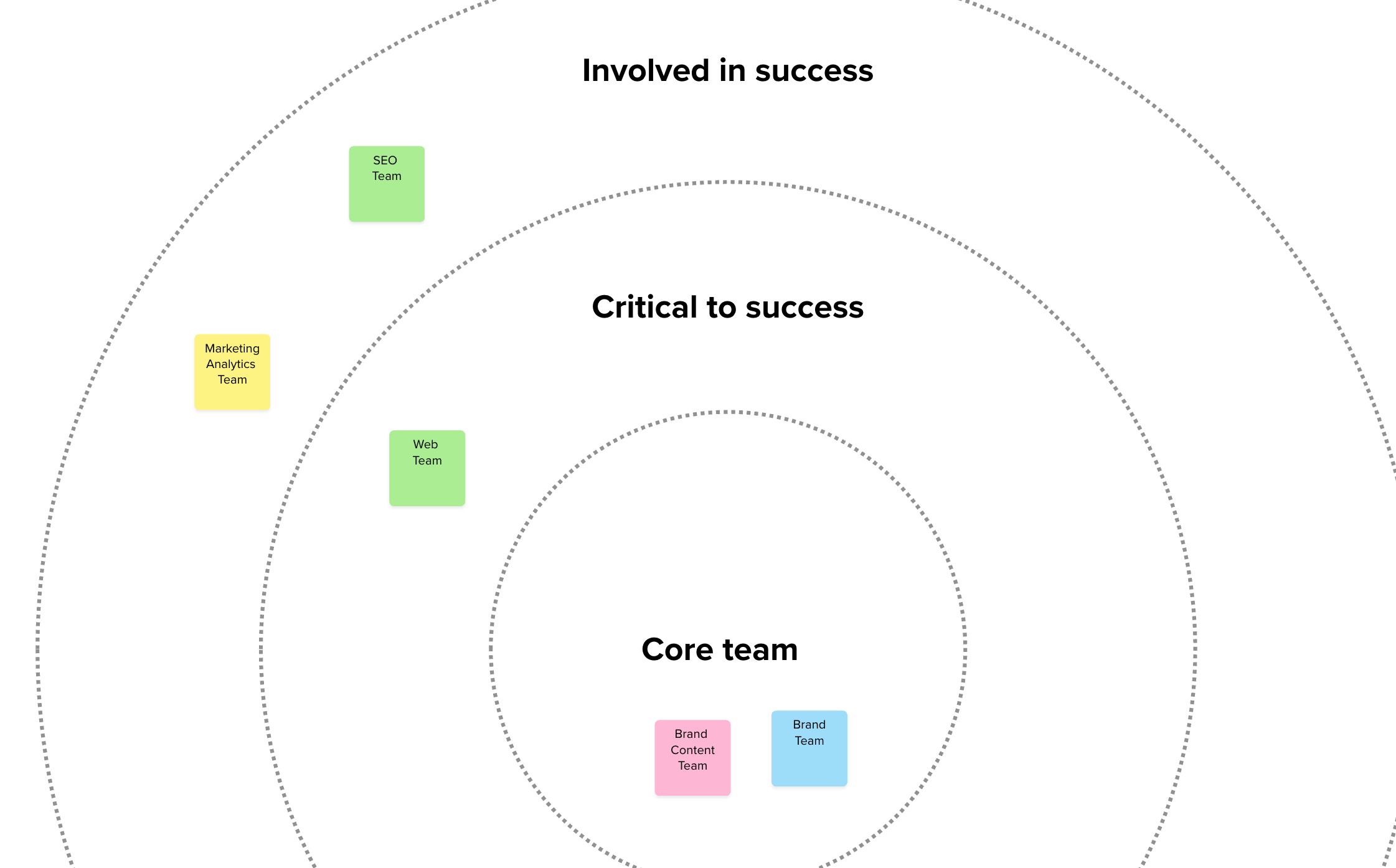Network of Teams
Map out your stakeholders and adjacent teams to identify who's involved in the success of a project and how to keep those relationships healthy.

PREP TIME
30m
Run TIME
60m
Persons
3-10
5-second summary
- Define team goals.
- Identify your network and its influence.
- Determine the health of your network relationships.
WHAT YOU WILL NEED
- Video conferencing with screen sharing or meeting space.
- Digital collaboration tool (see templates).
- Optional: physical whiteboard, markers, sticky notes, and timer.
PLAY resources
How to map out your network of teams
Map out and optimize cross-team relationships at the beginning of a project.
What is a “network of teams?”
A network of teams is a map that illustrates the adjacent collaboration networks (i.e. teams, stakeholders, leaders) involved in a project’s success, their level of influence on the project, and the person responsible for championing a healthy relationship with them throughout the project.
Why run a Network of Teams Play?
In today’s work environment, it’s uncommon for teams to work in isolation without collaborating with others to achieve their objectives. However, issues arise when teams realize too late in a project that they require help from others.
This Play helps you identify the specific network of teams needed to successfully complete a project before it starts, which helps reduce miscommunication, missed deadlines, and frustration.
When to use a Network of Teams Play at work
Use this Play during a project kickoff after the team has finished creating a team poster to ensure the best results. Additionally, a network of teams is a crucial element in shaping the team, and it can be utilized whenever a team is facing challenges in collaborating effectively.
3 benefits of a network of teams
- Collaboration: A network encourages cross-functional work, enabling diverse expertise and skills to come together.
- Innovation: Research shows that a diverse network fosters creativity as ideas flow between teams, leading to innovative solutions from cross-functional collaboration.
- Problem-solving: With multiple perspectives across teams, research suggests problems can be addressed more effectively and efficiently by leveraging the expertise of different members.
1. Set the stage
Est. time: 45 MIN
Before you run a Network of Teams Play, we recommend you establish your team poster. Running a Team Poster Play will define the team’s purpose and what success looks like. This helps your team understand what collaborators are needed to help you reach your goals.
Document the team’s strategic goal at the top of the shared template or whiteboard.
TIP: Run smaller groups
If you have more than 10 core team members, you should run the Play in smaller groups by creating breakout rooms to foster team communication. Then, combine the documentation and regroup to review the outcome together.
2. Prep the Play
Est. time: 5 MIN
Set up a space for your internal team to connect and invite any external team members you’d like to have present for the Play.
For remote teams, create a digital collaboration space or utilize one of our pre-made templates. For in-person teams, you’ll need space with a whiteboard, sticky notes in various colors, and markers.
TIP: Document it
Even if your team does this Play in person, make sure it is translated into an online document that can be shared and referred to later.
3. Start a Team Brainstorm
Est. time: 15 min
Start the Play with a team brainstorm. Identify the different teams in your network and classify them using two characteristics: type of team and level of influence.
Type of team:
- Delivery teams: Teams that create products and provide them to users, such as development teams
- Service teams: Teams that support internal or external customers by handing incoming tickets
- Leadership teams: Leaders and managers who guide decision-making and establish a framework for other teams to operate effectively
- Project teams: Temporary teams that build and execute plans to complete specific initiatives
- Business teams: Groups that manage profit and loss responsibilities while addressing key points in the customer journey
Level of influence:
- Core team: Teams and/or stakeholders highly involved in guiding the direction of a project
- Critical to success: Teams that hold significant influence, as their expertise and contributions are essential to achieving project goals
- Involved in success: Teams with a moderate level of influence. While they may not directly shape key decisions or lead critical phases, their support, and collaboration contribute to the smooth execution of the project
- Off the radar: Teams with no direct influence on the success of your project
4. Identify your network
Est. time: 10 min
Transfer that brainstorm to the template, shared document, or whiteboard. Under the appropriate team type, write the names of each team contributing to the goal.
5. Determine a team’s level of influence
Est. time: 10 min
Next, place the teams in their circles of influence. Remove duplicates and discuss which ring of influence the team should sit in. Try to have no more than five teams as Critical to Success.
6. Assign relationship owners
Est. time: 10 min
Assign and document a relationship “owner” from the core team for each of these “critical to success” and “involved in success” teams. This person will champion a healthy relationship with this team by maintaining communication, giving updates, and consulting as needed. If you can’t find a natural fit for the owner, ownership can default to the team lead.
Optional: Stop here! If you’re a newly formed team or have a less complex network, this may be enough. If your team has a shared understanding of the network, what it will take to be successful, and where to focus your efforts, then you’re done. Congratulations!
If you’d like to continue, take a quick break and then regroup.
TIP: Go bold!
Feeling bold? Why not ask the leaders from your critical teams to run this Play with their teams? If you identify network gaps, start by running the Roles and Responsibilities Play across teams.
7. Identify the health of each team relationship
Est. time: 5 min
Discuss the type of relationship you have between your team and each team you’ve determined to be critical. We call this your “interaction strength.” Draw lines to indicate the interaction strengths with each team.
Interaction strength:
- Solid line: Systemic interactions are happening (for example, a recurring meeting or dedicated Slack channel).
- Dashed line: Interactions are employed ad hoc. Examples are reliance on a personal relationship and collaboration that is reactive (incident or issue-driven).
- Dotted line: This relationship requires new collaboration methods.
For more challenging network interactions, run the variation below with your relationship owners.
Follow-up
Reflect regularly on your network of teams and re-run the Play every six months to account for relationship changes and team evolution.
Variations
Improving network health
Est time: 10 MIN
Gather your network team owners and prepare to assess the network's health. Each team will receive a health rating for specific categories with corresponding emojis. Ensure everyone understands the categories and has the opportunity to ask questions. Owners can rate their team relationships asynchronously or in real-time. Consider using a table, list, or whiteboard tool for the assessment, or use dots or stickers for in-person meetings.
Network health categories and suggested next steps
Visibility:
⛈️ Storm: Teams struggle to see each other's work.
☔️ Rain: Teams can see the work of other teams, but struggle to understand it.
☁️ Cloud: Teams know where to find high-level work but struggle to engage.
☀️ Sunshine: We have a shared understanding.
Play suggestion to improve visibility:
- Create a Project Poster to get everyone on the same page.
Coordination:
😡 Angry: Teams are unable to work together to build coordinated plans.
😭 Sad: Teams coordinate via favors and trading.
😐 Neutral: Teams only align on high-level plans.
😀 Happy: Teams prioritize together to build coordinated plans.
Play suggestions to improve coordination:
- Run Roles and Responsibilities to get clarity on how the teams will work together.
-
Try adopting transparent decision making with the DACI.
Alignment:
🙋♀️ Raised hand: Teams are not aligned because they don't think they need to be aligned, but in reality, they do need to be aligned.
👎 Thumb down: Teams struggle to align on goals and priorities.
👉 Thumb to side: Teams believe they are aligned, but are starting to struggle more.
👍 Thumb up: Teams fluidly align on and adapt to goals and priorities.
Play suggestions for improved alignment:
- Find strategic alignment through Goals, Signals, Measures.
-
Create a Customer Journey Map to build shared understanding of your customer.
Learning and Feedback:
🧘 Sitting: Teams aren’t able to share key learnings or feedback effectively.
🚶 Walking: Only one team shares learnings or feedback.
🚴 Bike: Teams share learnings or feedback but don’t apply any changes.
🚗 Car: Teams have established a way to learn and grow from one another.
Play suggestion for improved feedback:
- Run a cross-team Retrospective.

Still have questions?
Start a conversation with other Atlassian Team Playbook users, get support, or provide feedback.
Other plays you may like
Collaboration
Roles and Responsibilities
Clarify individual responsibilities and find gaps that need to be filled.
PROJECT PLANNING
Project Kick-Off
Build consensus on objectives, timing, scope, and decision-making.
Productivity
Working Agreements
Create shared norms that help your team work well together to achieve common goals.
Debriefs
5 Whys Analysis
Uncover the root of a problem and explore possible solutions.
Stay up to date
Get the latest Plays and work life advice when you sign up for our newsletter.
